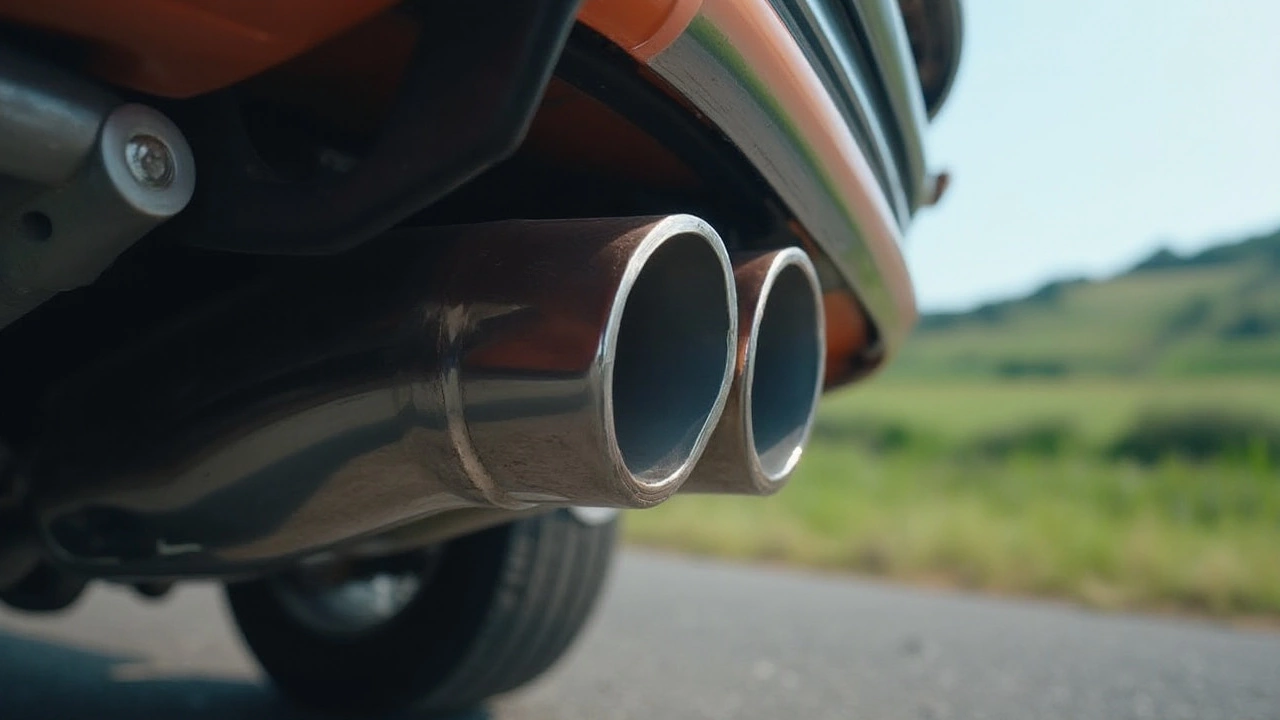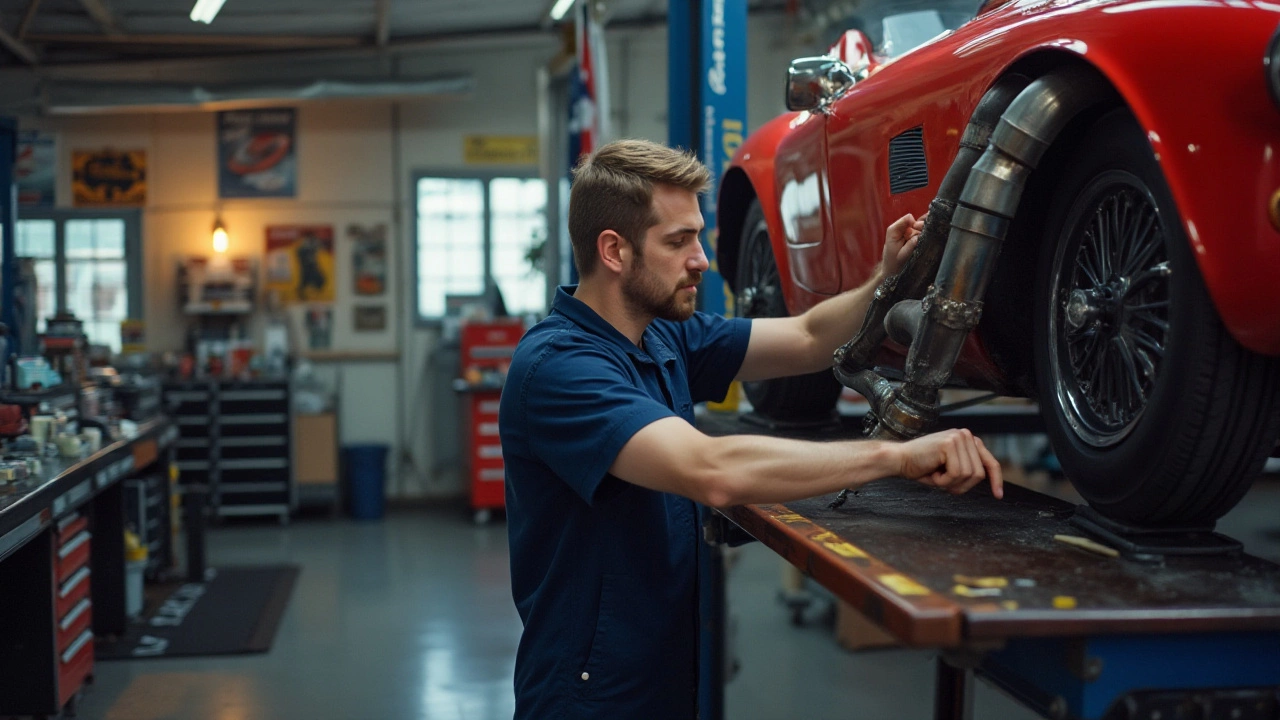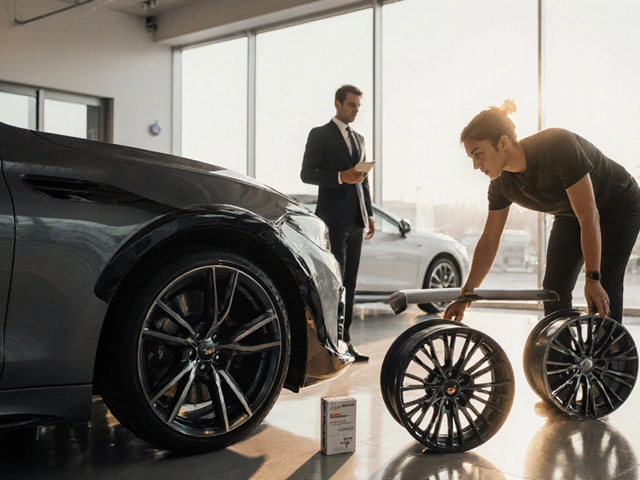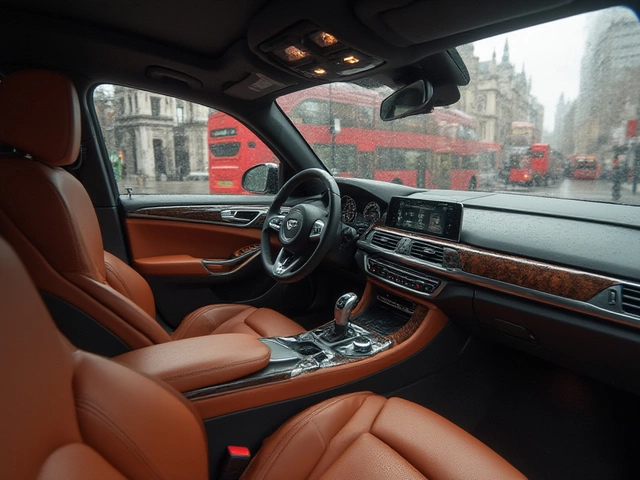Custom exhaust systems have become the go-to upgrade for automotive enthusiasts eager to boost their engine's performance and add a unique roar to their ride. While they promise enhanced efficiency and a thrilling new sound, one common question that arises is how long these custom pieces actually last. The answer is more complex than a simple number of years or miles.
The lifespan of a custom exhaust can be contingent on a variety of elements. From the quality of materials used to the harshness of your daily driving conditions, each factor plays a role in how long your investment will serve you. Whether you're cruising city streets or navigating rugged terrain, understanding the nuances of your exhaust system can help you stretch those dollars further while keeping your car in peak condition.
- Understanding Custom Exhaust Systems
- Factors Influencing Exhaust Lifespan
- Materials and Their Impact
- Maintenance Tips for Longevity
- Signs of Wear and When to Replace
- Choosing the Right Custom Exhaust
Understanding Custom Exhaust Systems
Custom exhaust systems represent a fascinating blend of engineering and art. They are tailored to enhance a vehicle's performance, improve its efficiency, and modify its sound profile. While factory-installed exhausts are designed with general usability in mind, custom systems are crafted to meet the specific tastes and needs of the vehicle owner, offering a personal touch to both performance and style. One of the primary motives behind upgrading to a custom exhaust is to improve engine efficiency by reducing the backpressure that standard exhausts often generate. This reduction allows for a freer flow of exhaust gases, potentially boosting horsepower and torque, which translates to an overall more powerful driving experience.
But it isn't all about power; sound plays a significant role here. Custom exhausts have the capacity to change the auditory signature of a vehicle, transforming a mundane hum into a growl or roar that suits the driver's personality. Choosing the right exhaust system can be like tuning an instrument to achieve that perfect pitch. As an interesting fact, some car enthusiasts liken the sound of a well-designed exhaust to a car's voice, stating that 'it's a conversation between the car and the road.' The materials used also play a critical role in determining the performance and life span of a custom exhaust. Stainless steel and aluminized steel are common options, each offering different combinations of durability, weight, and resistance to corrosion.
To ensure you're getting the most out of a custom exhaust, understanding the different components is crucial. A typical exhaust system comprises the headers, catalytic converters, resonators, mufflers, and the pipes themselves. Each of these components can be customized or configured in a multitude of ways to achieve the desired performance and sound characteristics. One notable mention is from the journal of Automotive Engineering, which notes that 'exhaust modifications remain among the top performed optimizations due to their immediate impact on driving dynamics.' For those seeking enhanced performance, performance headers can be installed to supplement the standard configuration, often resulting in improved airflow and efficiency.
The choice between a cat-back, axle-back, or the full exhaust system upgrade is another consideration. These terms refer to the sections of the exhaust pipes that are replaced during an upgrade. A cat-back exhaust replaces the system from the catalytic converter to the tailpipes, offering a balance of performance enhancement without the emissions risk. However, when it comes to a full overhaul, replacing the entire system, from the headers back, offers the greatest potential for performance improvements. Understanding these options is key to selecting the right system for your vehicle and driving style. This consideration highlights the importance of evaluating your goals, whether they be pure performance, sound modification, or a blend of both, when embarking on the custom exhaust journey.
"Understanding the precise balance between aesthetics and functionality is crucial when customizing exhaust systems," explains Automotive Weekly.
Factors Influencing Exhaust Lifespan
Understanding what determines the lifespan of a custom exhaust system can save you from unexpected costs and enhance your vehicle's performance. The first critical factor is the material used in constructing your exhaust. Stainless steel, for instance, is known for its resistance to rust and wear compared to the more commonly used mild steel. If you're opting for an exhaust system made from stainless steel, you can expect it to last twice as long as a mild steel variant due to its superior durability and resistance to corrosion. However, this longevity comes at a price, often leading to a higher initial investment. That said, for those driving in salty or moist climates, the benefits could far outweigh these costs.
Driving conditions and habits also play substantial roles in determining how long a custom exhaust lasts. Frequent short trips don't allow the exhaust system to heat up and burn off moisture, speeding up corrosion from the inside out. On the other hand, highway driving at consistent speeds lets the exhaust warm up adequately, reducing condensation and promoting a longer life span. If your vehicle frequently navigates rough roads, expect additional strain on the exhaust system, as constant vibrations can loosen parts and create leaks, leading to reduced efficiency and potential damage over time.
Beyond the materials and environmental factors, the design and installation quality of your exhaust system can immensely influence its durability. An expertly crafted system that aligns well with your vehicle's specifications not only boosts performance but also suffers less stress under normal conditions. Improperly installed or poorly designed systems can lead to unnecessary tension on the joints and fittings, eventually causing cracks or breaks. This is why it's essential to have your custom exhaust installed by a reputable professional who understands the intricacies of these systems.
Routine maintenance remains a vital factor in prolonging an exhaust system's life. Regular inspections help catch issues like loose fittings or minor cracks before they balloon into costly replacements. Understanding the importance of these checks and committing to a regular maintenance schedule can be the difference between an exhaust system that lasts a decade versus one that demands replacement every couple of years. As the saying goes, "An ounce of prevention is worth a pound of cure." A simple 30-minute check-up every six months can save far more time and money in the long run.
"Proper maintenance and quality material components are crucial in achieving a long-lasting exhaust. It's about choosing the right elements and caring for them over time," says Auto Mechanics Magazine.
In some regions, emissions and environmental regulations might call for specific types of exhaust systems, necessitating periodic checks to remain compliant. Not only could negligence in this area lead to fines, but it can also affect how well your system performs, making it crucial to stay informed about any changes in the law that might impact your vehicle. By understanding these various influences, from material choices and driving conditions to best maintenance practices and legal requirements, you'll be better equipped to make informed decisions about your custom exhaust system, ensuring it not only lasts longer but provides optimal performance throughout its life cycle.

Materials and Their Impact
The material of your custom exhaust can significantly shape its longevity and performance characteristics. When pondering over which option to choose, you're not just selecting a material—you're committing to a whole set of properties that will determine how well your exhaust performs and how long it lasts. A well-informed choice can mean the difference between years of top-notch performance or premature wear.
Two primary materials dominate the custom exhaust landscape: stainless steel and aluminized steel. Let’s dive into each to understand their unique qualities. Stainless steel is often heralded for its anti-corrosive properties and durability. Composed of chromium, nickel, and iron, it resists rusting and holds its sheen for longer periods. You might often see grades like 304 and 409 stainless steel mentioned. While 304 offers a higher nickel content and, thus, better resistance to corrosion, 409 provides better performance on the track due to its improved heat tolerance.
According to a study published by the Society of Automotive Engineers (SAE), "Selecting an appropriate exhaust material not only affects the vehicle’s acoustics but also its emission control efficiency."
Aluminized steel, on the other hand, presents itself as a budget-friendly option. It's essentially carbon steel with an aluminum-silicon alloy coating, providing decent rust resistance at a fraction of the cost of stainless steel. Although it's not as resistant to corrosion as stainless steel, many enthusiasts appreciate the balance it strikes between durability, weight, and price. However, it may need coatings or more maintenance to extend its lifespan. This type is especially preferred in vehicles not exposed to consistently harsh or salty environments.
Interestingly, the choice of material can also influence the exhaust system’s weight, which plays a crucial role in vehicle dynamics. Lighter materials, often found in high-performance and racing applications, contribute to better weight distribution and enhanced fuel efficiency. Titanium, though expensive, is another noteworthy contender that's revered for its lightweight and high-temperature tolerance, making it a darling for sports car exhausts despite its hefty price tag.
The Role of Coatings and Treatments
Protective coatings can bolster the longevity of your custom exhaust system, regardless of the material you choose. Ceramic coatings and heat wraps, for example, can help in reducing thermal fatigue by maintaining a lower surface temperature and thereby extending the life of your exhaust system. Keep in mind that these additional protections require careful application and periodic inspection.
Here's a brief look at common materials and their attributes:
| Material | Rust Resistance | Cost | Weight |
|---|---|---|---|
| Stainless Steel | High | Medium-High | Moderate |
| Aluminized Steel | Medium | Low | Moderate |
| Titanium | High | Very High | Low |
Ultimately, when selecting the ideal material for your custom exhaust, consider your vehicle's demands, budget constraints, and the environment in which you'll primarily drive. Each material comes with its advantages and trade-offs. Research and trials from trusted sources in the automotive industry can serve as valuable guides while navigating this decision. With a little foresight and due diligence, your choice of exhaust material can play a pivotal role in the longevity and satisfaction derived from your car modifications.
Maintenance Tips for Longevity
Ensuring the longevity of a custom exhaust system involves dedication to routine care and an understanding of the specific needs of these modified components. Regular maintenance is not merely about preventing damage but also about squeezing the most performance out of your investment as possible. A well-maintained exhaust system doesn’t just last longer; it performs better too. Regular checks can catch early signs of wear or potential issues which, if left unchecked, could lead to more serious problems down the line.
One essential tip is to periodically clean exhaust systems. Residual carbon and dirt can accumulate over time, which might hinder performance. Using a mild detergent or dedicated exhaust cleaner can help maintain the integrity of the system’s materials. Remember to allow the exhaust to completely cool before attempting any cleaning, as touching warm exhaust parts can lead to burns.
Also, pay close attention to the exhaust hangers. These rubber components that hold the exhaust in place are prone to wear due to heat and movement. Over time, they may crack or deteriorate, leading to a shaky exhaust. Checking these hangers frequently and replacing them when necessary can prevent undue stress on the entire system. As the well-reputed automotive journalist and mechanic, John Davis, once said:
"A properly supported exhaust system is like a well-fitted suit. It keeps everything looking sharp and functioning smoothly."
Another vital aspect is the materials used in your custom exhaust. Stainless steel is lauded for its durability and resistance to corrosion, but it’s still paramount to inspect for rust, especially in humid or coastal environments. Using rust-resistant coatings can also extend the life of the exhaust and protect your investment in the long run.
Finally, driving habits have a huge impact on the exhaust lifespan. Frequent short trips do not allow the exhaust system to warm up sufficiently, potentially leading to moisture buildup within the pipes. Longer drives help evaporate this moisture, protecting against internal corrosion. Keeping a balance between short and long drives can be hugely beneficial, not just for the exhaust, but for the entire vehicle.
- Periodic cleaning with appropriate tools and detergents
- Frequent inspection of exhaust hangers and rubber supports
- Regular checks for rust and application of protective coatings
- Balance short and long trips to prevent moisture accumulation
These steps require a bit of time and attention but ensuring the right care will undeniably pay dividends. Custom exhausts are not just about their look or sound; proper maintenance supports their longevity and performance, making each drive a more enjoyable experience.

Signs of Wear and When to Replace
Recognizing the signs of wear and deciding when it's time to replace your custom exhaust can save you from unexpected breakdowns and potential safety hazards. Typically, the first hint is an unusual noise—a rattling, hissing, or deep rumbling emanating from below the vehicle. These sounds often indicate issues such as loose components or a hole in the exhaust pipe. Regularly checking for these auditory clues during your daily drives can help catch problems early before they escalate.
Visible rust or corrosion is another telltale sign. While a little surface rust might seem harmless, progression to the structural components can significantly impair the exhaust’s integrity. If left unchecked, rust can eat through metal, leading to costly repairs or a complete system overhaul. Inspecting the undercarriage periodically, or having it checked by a professional mechanic during routine maintenance, can provide a clearer picture of your exhaust system's health.
Moreover, don't overlook performance issues; reduced fuel efficiency or decreased engine power can signify problems with the exhaust system. A blockage or leak might cause the engine to work harder, reducing performance and increasing emissions. Another key indicator is when you begin to notice unusual exhaust smoke; blue smoke might suggest oil is burning, while thick white smoke could point to a coolant leak into the engine, both requiring quick attention. During any of these occurrences, consulting with an expert can be invaluable in diagnosing and addressing the root cause of the issue.
For those who like hard data, a report from the National Institute for Automotive Service Excellence highlights that older vehicles, especially those exceeding ten years, have a higher likelihood of exhaust system failures. Here's a quick look at how wear varies by vehicle age:
| Vehicle Age (Years) | Probability of Exhaust System Failure |
|---|---|
| 1-3 | Low |
| 4-7 | Medium |
| 8-10 | High |
| 11+ | Very High |
Comments from seasoned custom exhaust enthusiasts often pivot around proactive care. According to Joe Mantel, an avid auto racer,
"A custom exhaust needs as much attention as your engine or tires. Don't wait till something shakes or rattles too loudly—by then, you might be too late!"This advice reflects the benefits of proactive management, reminding owners to balance their enthusiasm for performance with diligent oversight of system integrity and upkeep.
Choosing the Right Custom Exhaust
Selecting the right custom exhaust system for your vehicle is a decision that requires careful thought and consideration. It is not just about upgrading your car's performance, but also about matching the exhaust to the precise needs of your driving style and aesthetic preferences. When considering an upgrade, one must delve into the specifics of what each type can offer in terms of sound, efficiency, and durability. Stainless steel, for example, is incredibly popular due to its ability to resist rust, making it a prime choice for those living in wetter climates or who are frequently exposed to road salt. On the other hand, mild steel, though less resistant to corrosion, is often chosen for its affordability.
Another crucial aspect is the type of exhaust system you want to install. Cat-back systems, which include the components from the catalytic converter onwards, are typically favored for their ease of installation and substantial performance enhancement. Conversely, a header-back system could be a value-added choice, providing an even larger boost by replacing the entire exhaust line. The materials and system type must align with your performance expectations and budget constraints. If enhancing your vehicle's sound is top priority, you might consider opting for an axle-back system that affects only the rear section of your vehicle's exhaust – it's a solution that quickly changes the sound without extensive modification.
Keep in mind that the process isn't just about selecting piping. The muffler's design and the diameter of the exhaust pipes play significant roles in determining both the sound and performance levels. As quoted by Chris Thorn, a renowned automotive expert,
"The right exhaust is one that complements the car's characteristics and the driver's ambitions. It needs to be about synergy just as much as about sound."Such insights emphasize the importance of selecting a system designed to harmonize with your specific vehicle model.
In addition, considering regulatory standards is crucial when choosing an exhaust system. Make sure your desired custom exhaust adheres to emission regulations in your region. Non-compliance might land you hefty fines or the hassle of failing an emissions test, undermining the joy of your upgrade. A meticulous approach ensures you not only maximize your car’s performance and aesthetic upgrade but also stay aligned with environmental responsibilities.
An often overlooked, yet essential perspective is the long-term cost implications. While high-grade materials come with a steeper upfront cost, investing in quality may save on future repair and replacement expenses. You might bypass the frustration of premature wear with the right initial choice. Consulting with a reputable mechanic or visiting automotive forums could offer invaluable personalized advice based on user experiences and anecdotal knowledge, saving you both time and money in your decision-making process.




